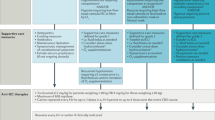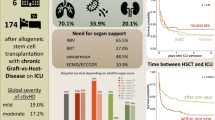Summary:
Acute regimen-related toxicity (RRT) is minimal in reduced-intensity stem-cell transplantation (RIST). However, the Seattle RRT grading (Bearman et al), developed in the context of conventional-intensity transplantation, is frequently applied to RIST. We compared the National Cancer Institute Common Toxicity Criteria (NCI-CTC) version 2.0 with the Seattle criteria after RIST in 86 patients. RRT within 30 days of transplant graded by both sets of criteria were significantly associated with the outcome confirming the predictive value of both the systems. A total of 15 patients died of disease progression, and 12 of transplant-related mortality: RRT (n=2), graft-versus-host disease (GVHD) (n=7), infection (n=1), and others (n=2). GVHD-related deaths primarily resulted from infections after steroid treatment (n=6) and bronchiolitis obliterans (n=1). This study shows that NCI-CTC is appropriate in toxicity evaluation of RIST, and that its application to RIST enables a toxicity comparison between RIST and other types of cancer treatments. Since GVHD is a significant problem in RIST, modifications are required to evaluate immunological complications following RIST.
This is a preview of subscription content, access via your institution
Access options
Subscribe to this journal
Receive 12 print issues and online access
$259.00 per year
only $21.58 per issue
Buy this article
- Purchase on Springer Link
- Instant access to full article PDF
Prices may be subject to local taxes which are calculated during checkout


Similar content being viewed by others
References
Giralt S, Estey E, Albitar M et al. Engraftment of allogeneic hematopoietic progenitor cells with purine analog-containing chemotherapy: harnessing graft-versus-leukemia without myeloablative therapy. Blood 1997; 89: 4531–4536.
Slavin S, Nagler A, Naparstek E et al. Nonmyeloablative stem cell transplantation and cell therapy as an alternative to conventional bone marrow transplantation with lethal cytoreduction for the treatment of malignant and nonmalignant hematologic diseases. Blood 1998; 91: 756–763.
Childs R, Chernoff A, Contentin N et al. Regression of metastatic renal-cell carcinoma after nonmyeloablative allogeneic peripheral-blood stem-cell transplantation. N Engl J Med 2000; 343: 750–758.
Khouri IF, Keating M, Korbling M et al. Transplant-lite: induction of graft-versus-malignancy using fludarabine-based nonablative chemotherapy and allogeneic blood progenitor-cell transplantation as treatment for lymphoid malignancies. J Clin Oncol 1998; 16: 2817–2824.
Saito T, Kanda Y, Kami M et al. Therapeutic potential of a reduced-intensity preparative regimen for allogeneic transplantation with cladribine, busulfan, and antithymocyte globulin against advanced/refractory acute leukemia/lymphoma. Clin Cancer Res 2002; 8: 1014–1020.
McSweeney PA, Niederwieser D, Shizuru JA et al. Hematopoietic cell transplantation in older patients with hematologic malignancies: replacing high-dose cytotoxic therapy with graft-versus-tumor effects. Blood 2001; 97: 3390–3400.
Bearman S, Appelbaum FR, Buckner C et al. Regimen-related toxicity in patients undergoing bone marrow transplantation. J Clin Oncol 1988; 6: 1562–1568.
Mielcarek M, Martin PJ, Leisenring W et al. Graft-versus-host disease after nonmyeloablative versus conventional hematopoietic stem cell transplantation. Blood 2003; 102: 956–962.
Niiya H, Kanda Y, Saito T et al. Early full donor myeloid chimerism after reduced-intensity stem cell transplantation using a combination of fludarabine and busulfan. Haematologica 2001; 86: 1071–1074.
Nakai K, Mineishi S, Kami M et al. The feasibility of reduced-intensity allogeneic hematopoietic stem cell transplantation from a related donor with HLA one-antigen with or without one-allele mismatch. Haematologica 2003; 88: 115–117.
Przepiorka D, Weisdorf D, Martin P et al. 1994 Consensus Conference on Acute GVHD Grading. Bone Marrow Transplant 1995; 15: 825–828.
Sullivan KM, Agura E, Anasetti C et al. Chronic graft-versus-host disease and other late complications of bone marrow transplantation. Semin Hematol 1991; 28: 250–259.
Kanda Y, Mineishi S, Saito T et al. Long-term low-dose acyclovir against varicella-zoster virus reactivation after allogeneic hematopoietic stem cell transplantation. Bone Marrow Transplant 2001; 28: 689–692.
Kanda Y, Mineishi S, Saito T et al. Response-oriented preemptive therapy against cytomegalovirus disease with low-dose ganciclovir: a prospective evaluation. Transplantation 2002; 73: 568–572.
Carella AM, Cavaliere M, Lerma E et al. Autografting followed by nonmyeloablative immunosuppressive chemotherapy and allogeneic peripheral-blood hematopoietic stem-cell transplantation as treatment of resistant Hodgkin’s disease and non-Hodgkin’s lymphoma. J Clin Oncol 2000; 18: 3918–3924.
Giralt S, Thall PF, Khouri I et al. Melphalan and purine analog-containing preparative regimens: reduced-intensity conditioning for patients with hematologic malignancies undergoing allogeneic progenitor cell transplantation. Blood 2001; 97: 631–637.
Khouri IF, Saliba RM, Giralt SA et al. Nonablative allogeneic hematopoietic transplantation as adoptive immunotherapy for indolent lymphoma: low incidence of toxicity, acute graft-versus-host disease, and treatment-related mortality. Blood 2001; 98: 3595–3599.
Nagler A, Slavin S, Varadi G et al. Allogeneic peripheral blood stem cell transplantation using a fludarabine-based low intensity conditioning regimen for malignant lymphoma. Bone Marrow Transplant 2000; 25: 1021–1028.
Nakai K, Mineishi S, Kami M et al. Antithymocyte globulin affects the occurrence of acute and chronic graft-versus-host disease after a reduced-intensity conditioning regimen by modulating mixed chimerism induction and immune reconstitution. Transplantation 2003; 75: 2135–2143.
Chakraverty R, Peggs K, Chopra R et al. Limiting transplantation-related mortality following unrelated donor stem cell transplantation by using a nonmyeloablative conditioning regimen. Blood 2002; 99: 1071–1078.
Author information
Authors and Affiliations
Consortia
Corresponding author
Rights and permissions
About this article
Cite this article
Sakiyama, M., Kami, M., Hori, A. et al. Regimen-related toxicity following reduced-intensity stem-cell transplantation (RIST): comparison between Seattle criteria and National Cancer Center Common Toxicity Criteria (NCI-CTC) version 2.0. Bone Marrow Transplant 34, 787–794 (2004). https://doi.org/10.1038/sj.bmt.1704673
Received:
Accepted:
Published:
Issue Date:
DOI: https://doi.org/10.1038/sj.bmt.1704673
Keywords
This article is cited by
-
Skin cancer after nonmyeloablative hematopoietic cell transplantation
Bone Marrow Transplantation (2006)



